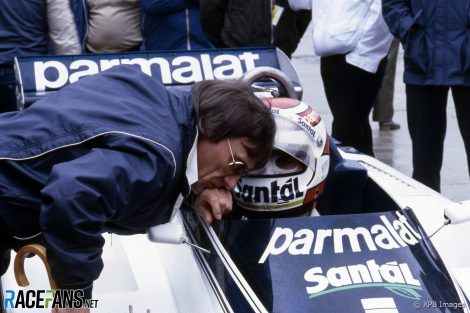Last year ex-Formula 1 boss Bernie Ecclestone earned a public rebuke from the series he once ran after making an unconscionable defence of Russian president Vladimir Putin following his invasion of Ukraine.
Ecclestone eventually walked back those comments, but he did not do the same regarding the support he also expressed for his former driver Nelson Piquet who had used a racial slur while discussing Lewis Hamilton. The seven-times world champion responded by stating “old voices” such as theirs should not be given publicity.
For those eager to understand the world’s most popular form of motorsport, the 92-year-old former driver, team boss and architect of F1’s commercial operation now run by Liberty Media is a uniquely significant but also controversial figure. Last year’s row was not the first time his pubic statements have attracted criticism, whether for likening women to domestic appliances, criticising democracy or praising Adolf Hitler (the latter another remark he later backtracked over).
So while Discovery+ snapped up the rights to Lucky!, an eight-part documentary covering Ecclestone’s seven decades in F1, it appears there was some sensitivity over being identified too closely with him. Each 45-minute (plus adverts) instalment therefore concludes with a disclaimer stating his views are his own and no one else’s.
It’s clear plenty of F1 fans feels they have heard enough from Ecclestone over the years. For them the prospect of six hours in his company will hold little appeal. All the more so given he is placed front-and-centre in Lucky!, appearing full frame in the interviews which make up the backbone of the feature.
This approach marks an obvious point of difference to the most famous work of Lucky!’s creator Manish Pandey, whose celebrated 2010 film Senna told its story entirely through voiceovers and thereby avoided the ‘talking heads’ trope familiar of so many documentaries. Having had access to Ecclestone for over eight weeks, filming him during Covid-19 lockdowns, Pandey chose to show him confronting the camera head-on.
This striking device is, thankfully, not over-used. What makes Lucky! essential viewing is the range and quality of material Pandey and his team have assembled from a broad range of archives to tell their tale. It’s in this respect that the series is most reminiscent of Senna, and there is plenty of rare footage in here dedicated F1 fans will not want to miss out on seeing.
Advert | Become a RaceFans supporter and
Ecclestone’s progress from manager of drivers to overseer of the sport’s commercial operation forms the bulk of the narrative. Clearly this presents more of a challenge for the film makers when the story focuses on off-track rather than on-track matters. In places animations have been used to sketch in unseen scenes, but like the Ecclestone footage these are used sparingly.

Where the programme makers have really done themselves proud is in assembling a broad collection of archive footage which goes far beyond what is contained in the substantial catalogue produced by Ecclestone’s FOM operation. Contemporary news and current affairs reports flesh out the details of the stories which Ecclestone tends to relate in simplistic terms.
There are some obscure gems of coverage here which I will try to avoid spoiling here. Past Ecclestone adversaries such as Patrick Duffeler appear. Those who enjoyed Senna will spot FISA president Jean-Marie Balestre popping up as a nemesis figure once more, grousing about the English killing Joan of Arc in his first appearance, and providing the series’ lighter moments with his aptitude for buffoonery.
In sharp contrast to this are the series’ regular poignant moments, an inevitable consequence of the fact so many of the drivers who raced in F1 during this period met untimely ends. Although the footage from several of the incidents is often shocking, they are handled with sensitivity.
Even with a six-hour running time (it’s advertised as eight, but that banks on 15 minutes of adverts per episode), covering 67 years of motor racing history in that time is no small feat. The story therefore hurries on in places to make room for the matters of most significance.
Inevitably some details are therefore covered so briefly you wonder why they were left in at all, particularly those which only seem to have a passing connection to the Ecclestone story. The shot of a very young Damon Hill rushing up to greet his father tugs at the heart-strings, but this sequence detailing Graham Hill’s unexpected death passes by very briefly.
Advert | Become a RaceFans supporter and
Another short section covers the controversy around the 1985 South African Grand Prix, the last held during the Apartheid era, long after other sports had left the country. Senna and Nigel Mansell state their misgivings about competing in the racially segregated country, but tellingly there is only the briefest of acknowledgements from Ecclestone that he stopped racing there, for unspecified reasons.
Scenes like this underline that Lucky! demands to be watched with a critical eye. As Pandey told RaceFans, this is very much Ecclestone’s version of events, and it’s down to the viewer to decide how much of it they take at face value.
But what is there is a fascinating, detailed, well-researched survey of seven decades of F1 history, as told by the man who orchestrated so much of it. While the condemnation Ecclestone’s statements have faced is justified, it would be unfortunate if they discouraged F1 fans from seeking out Lucky!.
‘Lucky!’ is available to watch in the UK on Discovery+
Become a RaceFans Supporter
RaceFans is run thanks in part to the generous support of its readers. By contributing £1 per month or £12 per year (or the same in whichever currency you use) you can help cover the costs of creating, hosting and developing RaceFans today and in the future.
Become a RaceFans Supporter today and browse the site ad-free. Sign up or find out more via the links below:
















